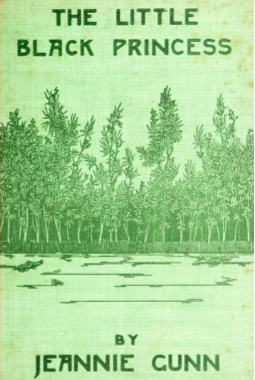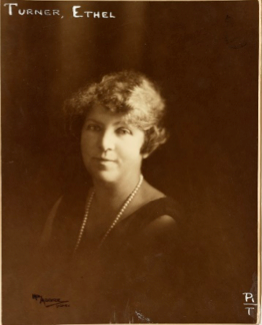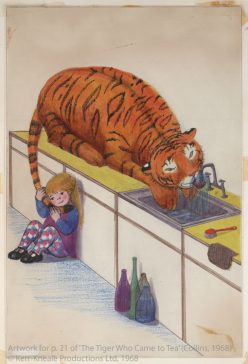Roisín Laing
The stereotyped ‘redskins’ in J. M. Barrie’s Peter Pan (1904), Enid Blyton’s The Three Golliwogs (1944), the Oompa-Loompas in Roald Dahl’s Charlie and the Chocolate Factory (1964): children’s literature is saturated with racism. Whether the racism is naïve, or ironic, or intentionally offensive, it is consistent in one respect: it calls into question the humanity of its object.
The humanity of various races was openly debated, and hierarchically organised, in the nineteenth century. Indigenous Australians were at the very bottom of this hierarchy of humanity. British men, as the most influential contributors to this debate, were at the top. This provided a paternalistic rationale for a range of British colonial activities in Australia.

Jeannie Gunn’s The Little Black Princess (1905) typifies a superficially benign form of that paternalism. The eponymous child, Bett-Bett, ‘must have been a princess, for she was a King’s niece’.[1] She is also, however, ‘just a little bush nigger girl’, whom the narrator endeavours to assimilate into white society for her own good.[2] In other words, Bett-Bett is a fictional pilot run for the reality of the Stolen Generations.
The narrator implies that Bett-Bett fails to become a little white princess because of her irredeemable blackness. The text itself, however, implies that the narrator fails to control Bett-Bett’s impertinent and energetic resistance. Despite the racist ideology underlying the narrative voice of The Little Black Princess, its child-protagonist suggests that Indigenous Australians are not incapable of attaining white civilization. Rather, they are unwilling to adopt it in exchange for their own civilization.
Ethel Turner’s Seven Little Australians (1894) is more insidious. ‘In Australia’, Turner begins;
a model child is—I say it not without thankfulness—an unknown quality. It may be that the miasmas of naughtiness develop best in the sunny brilliancy of our atmosphere. It may be that the land and the people are young-hearted together, and the children’s spirits are not crushed and saddened by the shadow of long years’ sorrowful history. There is a lurking sparkle of joyousness and rebellion and mischief in nature here, and therefore in children. [3]
Turner’s version of Australia has been expunged of Indigenous Australians altogether.

Seven Little Australians therefore attains an end in fiction which nineteenth-century evolutionary theory had predicted would come about in fact. When Charles Darwin claimed that ‘The thoughtless [Australian] aboriginal…is delighted by the approach of the white man, who seems predestined to inherit the country of his children’, he lent scientific legitimacy to Gunn’s paternalistic effort to protect Bett-Bett and her community from their supposedly self-inflicted annihilation, and presented Turner’s whitewashed Australia as the inevitable outcome of the difference between Indigenous Australian and British people.[4] Of course, Darwin, Gunn, and Turner thereby erase the countless massacres of Indigenous Australians by British settlers throughout the nineteenth century which, along with disease and enforced starvation, actually propagated the decimation of the Indigenous Australian population.
Around the time when Darwin was writing up his ideas about ‘thoughtless Aboriginals’, two Indigenous Australians were recording their experience of white men in Australia. Thomas Brune and Walter George Arthur wrote and edited The Flinders Island Chronicle, the first Aboriginal newspaper in Australia. The Chronicle was heavily censored by G. A. Robinson, the British commandant of the Flinders Island settlement. This accounts for the many passages devoted either to praising Robinson himself, or to promoting Christianity.
The dissent and disgust of the newspaper’s self-signed ‘Aboriginal youths’ become clear, however, on closer reading. On 17th November 1837, for example, Brune seems to praise the commandant:
so kind to you he gives you everything that you want…he brought you out of the bush because…he knowed the white men was shooting you and now he has brought you to Flinders Island where you get everything and when you are ill tell the Doctor immediately and you get relief.[5]
But the final paragraph belies this account of Flinders Island as a safe haven for Aboriginal people:
The brig Tamar arrived this morning…Let us hope it will [bring] good news and that something may be done for us poor people they are dying away the Bible says some of all shall be saved but I am much afraid none of us will be live by and by as then as nothing but sickness among us. Why don’t the black fellows pray to the king to get us away from this place.[6]
Brune becomes even franker about the conditions on Flinders Island in later issues of the Chronicle. On 7th December 1873, he wrote that ‘I got rite to you the same things over and over again. Commandant has directed me to work and if I don’t attend to it I must be put in to jail’.[7] Robinson ended the Chronicle’s run shortly after this issue.
The Flinders Island Chronicle falsifies the observations nineteenth-century evolutionists made about the intelligence (and the humanity) of Indigenous Australians. It also provides a salutary point of reference for the colonial Australian fiction which emerged in dialogue with this scientific racism. Turner’s Seven Little Australians erases Australia’s Indigenous peoples, and thereby erases the atrocities of the British colonial project there. Gunn’s The Little Black Princess attempts to idealise a British colonial encounter with an Indigenous child, but is only partially successful. The Flinders Island Chronicle emblematises the difference between Turner’s version of British Australia and Gunn’s: its content and eventual fate indicate that it is easier to establish British colonial supremacy by eradicating Indigenous Australian voices than by attempting to control them.
Ultimately, the Chronicle suggests that one way of addressing racism in children’s literature might be to attend to those voices which such literature ignores or misrepresents; to read an era’s most popular and most literary fiction in dialogue with its neglected, obscured, or undervalued texts. To do so would be to recognise the humanity of the authors of these abandoned texts, and might thus help to contradict the dehumanising effect of racism itself.
Roisín Laing completed her PhD at Durham University and is a Visiting Research Fellow at the University of Sydney.
Lead Image: Message stick, Kimberley Aboriginal peoples, collected from north-west Western Australia by Sir Frederick Napier Broome in 1884, 25.4 x 2.3 x 0.5 cm. British Museum Oc,+.2424.
[1] Jeannie Guun, The Little Black Princess: A True Tale of Life in the Never-Never (London: De la More Press, 1905), p. 1.
[2] Gunn, p. 1.
[3] Ethel Turner, Seven Little Australians (London: Ward, Lock and Co., 1912), p. 9-10.
[4] Charles Darwin, The Voyage of the Beagle (London; Wordsworth Classics) p. 641.
[5] Thomas Brune, The Flinders Island Chronicle, 17th November 1837, in For the Record: 160 Years of Aboriginal Print Journalism, ed. Michael Rose (St. Leonards: Allen and Unwin, 1996), p. 17.
[6] Brune, p. 17.
[7] Brune, The Flinders Island Chronicle, 7th December 1837, p. 18.

